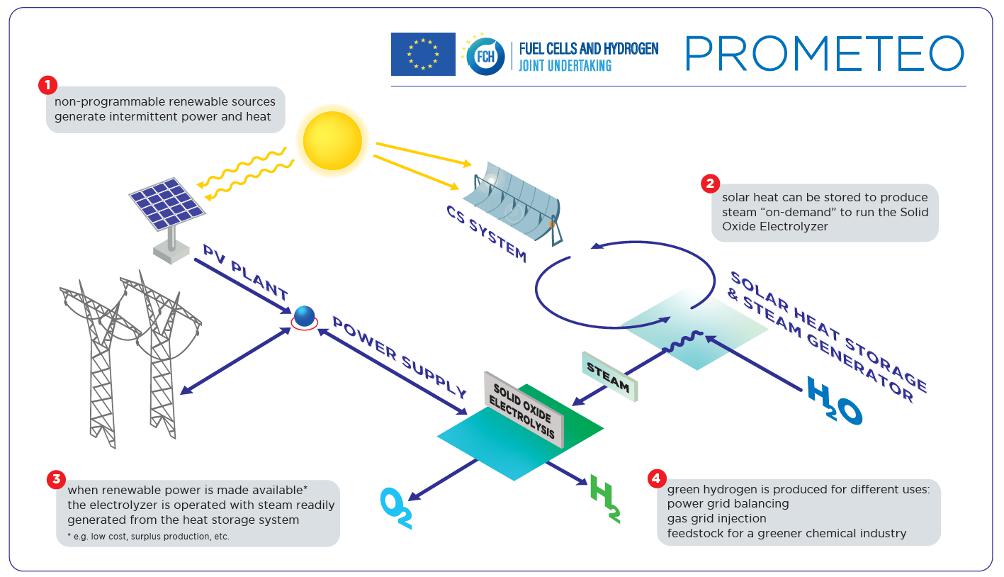Clean hydrogen can reduce the climate impact of industries
EPFL engineers are taking part in PROMETEO – an EU research project to generate hydrogen on a large scale from renewable sources, in an effort to lower industrial carbon emissions.
Whether used as a fuel or as a storage medium, hydrogen is a perfectly clean energy source. However, the processes used to make it are not, since they still rely mainly on electricity or fossil fuels like oil, gas and coal. Under PROMETEO, an EU project launched earlier this year, engineers will work to develop a new system for the large-scale production of clean hydrogen, using only renewable energy sources. This would help lower the carbon emissions of many major manufacturing industries. Jan Van Herle's research group at EPFL Valais-Wallis in Sion is taking part in this initiative.
The idea is to build a prototype that uses electrolysis to extract hydrogen from water – the “H” in H2O. But rather than using water in its liquid form, as is normally done, the new system will use steam and solid oxide electrolysis (SOE) technology, which calls for temperatures of over 700°C. The heat and energy needed to run the prototype will come entirely from solar energy.
The prototype is expected to produce about 15 kg of hydrogen per day. To address the intermittent nature of solar energy resulting from variations in sunlight, the engineers will trial an innovative strategy for managing the various phases of energy conversion (electrolysis, generating electricity, and keeping the electrolyser in a "hot stand-by" mode). Their strategy involves minimizing drawdown from the power grid and increasing generation from stored renewables whenever solar energy (or wind energy, for the electrolysis phase) is unavailable.

“By using steam electrolysis to supply hydrogen, our system will use a third less power than is currently required for water electrolysis. This is already a huge savings, as power is the most expensive budget item in an electrolysis plant's operating costs,” says Van Herle from the School of Engineering, whose group is specialized in SOE. “But the real advantage of solid oxide technology is that it is also reversible, meaning it can generate power on demand, which is then fed into the grid. Our converter will always be operational in one direction or the other, overcoming the problem of intermittency and making the most efficient use of solar heat and energy. Conventional liquid water electrolysers, on the other hand, spend a lot of time sitting idle.”
PROMETEO will be coordinated by the Italian National Agency for New Technologies, Energy and Sustainable Economic Development (ENEA), which will head up an interdisciplinary consortium of nine European organizations* including EPFL. This bold, 3.5-year project has received €2.5 million in funding from the European Commission. It is intended to help meet the Commission's climate targets for 2030 and 2050, in particular by boosting the adoption of renewable energy sources by industries that use a great deal of hydrogen, such as the petrochemicals, metallurgy, ammonia and methanol synthesis, and hydrogen fuel-cell industries. PROMETEO engineers will also study the potential to replicate their process on an industrial scale. SOLIDpower, the company that developed the technology, has already showcased a system that can produce 50 kg of hydrogen per day, and is now working on scaling this up.
*ENEA is working with Fondazione Bruno Kessler in Italy, IMDEA Energy in Spain, and EPFL in Switzerland to model the prototype. SOLIDpower, an Italian-Swiss SME, will supply the solid oxide electrolysers and the thermoregulation system. Other organizations involved in PROMETEO are Maire Tecnimont Group in Italy, NextChem in Italy, Stamicarbon in the Netherlands, Snam in Italy, and Capital Energy in Spain.
To know more about it:ENEA press release, March 25th, 2021
